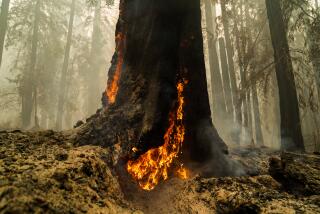Book review: ‘Fire Season: Field Notes From a Wilderness Lookout’

Fire Season: Field Notes From a Wilderness Lookout
Philip Connors
Ecco Press; 246 pp., $24.99
With its glowing orange cover and title, “Fire Season” looks like another western tale of man versus flame.
It turns out to be far rarer than that: a quirky meditation on the lonely pleasures of summers in a 7-by-7-foot lookout tower in a particularly wild patch of the Southwest.
Every April, Philip Connors leaves behind his bartending job and his wife, Martha, in a small New Mexico town and heads for Apache Peak in the nearby Gila National Forest.
He takes his dog Alice, an old Olivetti typewriter, some stashes of bourbon and settles in for five months of professional mountain watching in country where the view holds “no evidence of human presence, not one light to be seen.”
He spends his days gazing, writing, reading and mentally losing himself in the million-acre vastness that stretches in every direction from his glass-walled perch. He finds entertainment in the play of light, the rustle of the breeze, the unscripted drama of the wild.
It is here — 10,010 feet above sea level and 51/2 miles from the nearest road — that he is perhaps his “truest self.”
Connors’ tools are simple: a penchant for patient observation, good binoculars and an Osborne Firefinder to plot the location of a curl of smoke lazily rising in the distance.
The tower shakes with screeching winds in the spring. In the summer, lightning rains down on the peak. A fire sighting triggers a rush of adrenaline.
But for the most part, he writes with relish, a lookout’s life is “a blend of monotony, geometry and poetry, with healthy dollops of frivolity and sloth.... We are paid to master the art of solitude.”
Not everyone can. A rookie hired just days out of high school to man the tower on Connors’ days off hikes up the mountain with his cellphone. Taken aback when he finds the signal is too weak to text his girlfriend, the teenager barely lasts the weekend. Connors never sees him again.
The Apache Peak tower is one of only a few hundred still staffed by the U.S. Forest Service, which in this era of instant communication and flyovers has turned to other means of fire spotting.
The season is quiet. There are fires, some caused by lightning, some by people. But none that require much fighting. The Gila helped pioneer a federal policy that is slowly moving the Forest Service away from its traditional Smokey-Bear mind-set that all wildfire is the enemy, requiring a military-scale assault.
If a blaze is sparked by lightning, doesn’t threaten communities and isn’t too intense, public lands managers can opt to monitor it rather than calling in a small army of firefighters. The goal is to let the flames perform their natural ecological function, which was subverted by a century of fire suppression that turned many forests into overgrown, fire-starved thickets.
In the pine savannas of New Mexico’s high country, the natural regime was one of frequent, low-burning wildfires that crept through the underbrush for weeks or months at a time. Connors keeps his eye on a couple of such fires while they do a leisurely clean-up job on more than 25,000 acres.
As the season unfolds he weaves in local history, field notes and the story of how the Gila managed to stay so wild.
After witnessing the speed with which roads and logging were chewing their way through the Southwest’s national forests, Aldo Leopold in the 1920s persuaded his Forest Service bosses to place the heart of the Gila off limits. It became the nation’s first officially proclaimed wilderness area, a rugged outpost relatively unmolested by humans, if not completely free of their influences.
The reader comes to know and like not just the Gila, but Connors, who grew up on a farm in the Midwest. Even then, when there was nothing to see but endless rows of corn and beans, he climbed the silo to look out on his world.
Only part hermit, Connors hikes down the mountain every other week for a few days in town to recharge his social batteries and spend time with his wife, whom he met in New York City after quitting his job as a copy editor for the Wall Street Journal.
The worst conflagration he has experienced was 9/11. The trek to his office in Lower Manhattan that day was more perilous than any of his backcountry encounters with a bear.
Connors’ language sometimes overreaches. But he has written a quietly moving love letter to a singular place. By the last page, I wanted to hike up to the tower, sip some whiskey with him and just look.
Times staff writers Boxall and Julie Cart were awarded the Pulitzer Prize in explanatory reporting in 2009 for a series of stories on the growing menace of wildfires across the western United States.
More to Read
The biggest entertainment stories
Get our big stories about Hollywood, film, television, music, arts, culture and more right in your inbox as soon as they publish.
You may occasionally receive promotional content from the Los Angeles Times.







